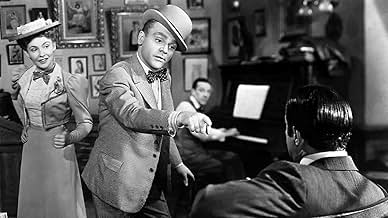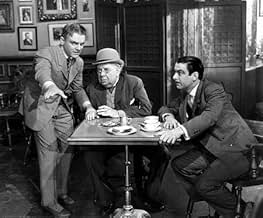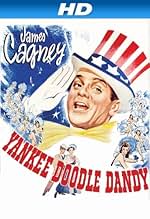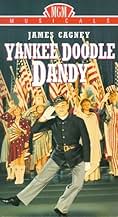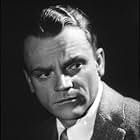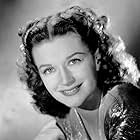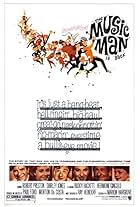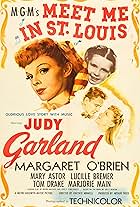NOTE IMDb
7,6/10
17 k
MA NOTE
Ajouter une intrigue dans votre langueThe life of the renowned musical composer, playwright, actor, dancer, and singer George M. Cohan.The life of the renowned musical composer, playwright, actor, dancer, and singer George M. Cohan.The life of the renowned musical composer, playwright, actor, dancer, and singer George M. Cohan.
- Récompensé par 3 Oscars
- 6 victoires et 6 nominations au total
Patsy Parsons
- Josie Cohan - As a Girl of 12
- (as Patsy Lee Parsons)
Histoire
Le saviez-vous
- AnecdotesMany facts were changed or ignored to add to the feel of the movie. For example, the real George M. Cohan was married twice, and although his second wife's middle name was Mary, she went by her first name, Agnes. In fact, the movie deviated from the truth to such a degree that Cohan's daughter Georgette commented, "That's the kind of life Daddy would have liked to have lived."
- GaffesThe "You're A Grand Old Flag" number, supposedly takes place in the 1906 production of "George Washington Jr.," and uses multiple period flags to represent times before 1906. The Civil War flag, as an example, is correct for the time in question. However, in the final sequence characters carry, and an soft screen projection is made of, multiple 48 star flags. The 48 star flag was not introduced until 1912. In 1906, it should have been a 45 star flag. (Oklahoma was admitted to the Union in 1907, New Mexico and Arizona in 1912).
- Citations
George M. Cohan: My mother thanks you, my father thanks you, my sister thanks you, and I thank you.
- Versions alternativesAlso available in a computer colorized version.
- ConnexionsFeatured in The Voice That Thrilled the World (1943)
- Bandes originalesThe Yankee Doodle Boy
(1904) (uncredited)
from the Broadway Show "Little Johnny Jones"
Written by George M. Cohan
Played during the opening credits
Sung and Danced by James Cagney and Chorus
Commentaire à la une
YANKEE DOODLE DANDY (Warner Brothers, 1942), directed by Michael Curtiz, is an autobiographical musical of a legendary Broadway showman, composer, actor and dancer, George M. Cohan (1878-1942), as played by James Cagney in what's been reported as his personal favorite of all movie roles, and it's easy to see why. In spite the fact that Cagney won his only Academy Award as best actor, he was letter perfect in the role as Cohan. Interesting to see a noted movie tough guy singing and dancing, but it's even more-so in watching Walter Huston as Cohan's father doing a song and dance himself.
The story opens with the middle-aged Cohan (James Cagney), following a comical musical performance in "I'd Rather Be Right" in which he plays and spoofs the president (Franklin D. Roosevelt). He gets a telegram from the president himself to meet with him at the White House. Believing the worst, he arrives to meet "with the head man." Alone with him in the Oval Office, the two men converse which leads to Cohan to soon be relating his life story via flashback starting with his birth (born on the 4th of July), as the son of stage entertainers, Jerry and Nellie Cohan (Walter Huston and Rosemary DeCamp), followed by his boyhood days as the star of "Peck's Bad Boy" (Douglas Croft playing George at age 12), the teaming up with his younger sister, Josie (first played by JoAnn Marlowe, then by Patsy Lee Parsons, and by Jeanne Cagney as an adult) and his parents, forming the act called "The Four Cohans," George leaving the family to form an act on his own, his association with a young hopeful named Mary (Joan Leslie), whom he eventually marries, the publication of his songs that make him world famous, the death of his parents, his retirement from the stage and his return to Broadway to appear in a play that has summoned him with an invitation from the president, and after nearly two hours of recollection, the story moves forward to present day with Cohan to find out why he was really asked to come to visit with the president.
With a handful of song and dance tunes, many composed by Cohan himself, the soundtrack is as follows: "The Dancing Master," "The Dancing Master" (reprise); "Strolling Through the Park One Day" (by Joe Goodwin and Gus Edwards); "Minstrel Number," "I Was Born in Virginia," "The Warmest Baby in the Bunch," "Harrigan," "Yankee Doodle Dandy," "Yankee Doodle Dandy," "All Aboard for Old Broadway" (by Jack Scholl and M.K. Jerome), "Give My Regards to Broadway," "Oh, You Wonderful Girl," "Blue Skies, Grey Skies," "The Barber's Ball," "Mary," "Forty-Five Minutes From Broadway," "Mary" (reprise); "Forty-Five Minutes From Broadway," "So Long, Mary," "You're a Grand Old Flag," "Battle Hymn of the Republic" (by William Steffe and Julia Ward Howe); "When Johnny Comes Marching Home," "Of Thee I Sing," "You're a Grand Old Flag," "Come Along With Me," "Over There," "I'm Happy As Can Be," "Love Nest" (by Louis A. Hirsch and Otto Harbach); "Little Nellie Kelly," "The Man Who Owns Broadway," "Molly Malone," "Billie," "Jeepers Creepers" (by Johnny Mercer and Harry Warren); "Off the Record" and "Over There." Of the songs listed above, several could have been chosen as alternate titles in regards to Cohan, including: "Give My Regards to Broadway," "Grand Old Flag," "The Man Who Owns Broadway," or "Off the Record," but the final selection became "Yankee Doodle Dandy." While many of these songs are Broadway show tunes, the most memorable ones happen to be the patriotic songs, especially "Grand Old Flag," "Over There," and of course, the title tune.
In the supporting cast are Irene Manning (Fay Templeton); Richard Wholf (Samuel H. Harris); George Tobias (Mr. Dietz); George Barbier (Claude Erlanger); S.Z. Sakall (Mr. Schwab); Eddie Foy Jr. (Eddie Foy); Minor Watson (Edward Albee); and Frances Langford credited as a singer, but actually Nora Bayes. Listed bottom in the cast is Captain Jack Young as The President, who, during the opening and closing segments, is only visible by a back-view depiction.
YANKEE DOODLE DANDY started a new trend of bio-musicals that would become fashionable throughout the 1940s. As a movie, YANKEE DOODLE DANDY is a grand old musical that blends nostalgia of the past (early twentieth century, World War I) with patriotism of the 1940s. While very little is known of the real George M. Cohan today, the inaccuracies wouldn't really matter nor noticed. Cohan was actually married twice, but never to a girl named Mary. The screenplay, overall, fails to mention Cohan actually appeared in some motion pictures, one being THE PHANTOM PRESIDENT (Paramount, 1932) opposite Claudette Colbert. To watch that Cohan film is to see how close Cagney worked to impersonate him on screen. YANKEE DOODLE DANDY is true indication of Cagney not just as a movie tough guy, but his diversatility as an actor. Although the patriotism plays towards the World War II audience, much of Cohan's spirit of being an American continues to reflect upon the present generation.
Full of memorable lines, YANKEE DOODLE DANDY's most noted happens to be Cohan's closing speech following a performance, "My father thanks you, my mother thanks you, my sister thanks you, and I THANK YOU." Filmed with crisp black and white photography, YANKEE DOODLE DANDY did go through the process of colorization in the mid 1980s. While original Technicolor photography might have been its major asset, YANKEE DOODLE DANDY still ranks first rate entertainment for all ages, and one responsible in keeping the George M. Cohan name more alive today than ever before. Available on video cassette, DVD and through presentations on Turner Classic Movies. (**** flags)
The story opens with the middle-aged Cohan (James Cagney), following a comical musical performance in "I'd Rather Be Right" in which he plays and spoofs the president (Franklin D. Roosevelt). He gets a telegram from the president himself to meet with him at the White House. Believing the worst, he arrives to meet "with the head man." Alone with him in the Oval Office, the two men converse which leads to Cohan to soon be relating his life story via flashback starting with his birth (born on the 4th of July), as the son of stage entertainers, Jerry and Nellie Cohan (Walter Huston and Rosemary DeCamp), followed by his boyhood days as the star of "Peck's Bad Boy" (Douglas Croft playing George at age 12), the teaming up with his younger sister, Josie (first played by JoAnn Marlowe, then by Patsy Lee Parsons, and by Jeanne Cagney as an adult) and his parents, forming the act called "The Four Cohans," George leaving the family to form an act on his own, his association with a young hopeful named Mary (Joan Leslie), whom he eventually marries, the publication of his songs that make him world famous, the death of his parents, his retirement from the stage and his return to Broadway to appear in a play that has summoned him with an invitation from the president, and after nearly two hours of recollection, the story moves forward to present day with Cohan to find out why he was really asked to come to visit with the president.
With a handful of song and dance tunes, many composed by Cohan himself, the soundtrack is as follows: "The Dancing Master," "The Dancing Master" (reprise); "Strolling Through the Park One Day" (by Joe Goodwin and Gus Edwards); "Minstrel Number," "I Was Born in Virginia," "The Warmest Baby in the Bunch," "Harrigan," "Yankee Doodle Dandy," "Yankee Doodle Dandy," "All Aboard for Old Broadway" (by Jack Scholl and M.K. Jerome), "Give My Regards to Broadway," "Oh, You Wonderful Girl," "Blue Skies, Grey Skies," "The Barber's Ball," "Mary," "Forty-Five Minutes From Broadway," "Mary" (reprise); "Forty-Five Minutes From Broadway," "So Long, Mary," "You're a Grand Old Flag," "Battle Hymn of the Republic" (by William Steffe and Julia Ward Howe); "When Johnny Comes Marching Home," "Of Thee I Sing," "You're a Grand Old Flag," "Come Along With Me," "Over There," "I'm Happy As Can Be," "Love Nest" (by Louis A. Hirsch and Otto Harbach); "Little Nellie Kelly," "The Man Who Owns Broadway," "Molly Malone," "Billie," "Jeepers Creepers" (by Johnny Mercer and Harry Warren); "Off the Record" and "Over There." Of the songs listed above, several could have been chosen as alternate titles in regards to Cohan, including: "Give My Regards to Broadway," "Grand Old Flag," "The Man Who Owns Broadway," or "Off the Record," but the final selection became "Yankee Doodle Dandy." While many of these songs are Broadway show tunes, the most memorable ones happen to be the patriotic songs, especially "Grand Old Flag," "Over There," and of course, the title tune.
In the supporting cast are Irene Manning (Fay Templeton); Richard Wholf (Samuel H. Harris); George Tobias (Mr. Dietz); George Barbier (Claude Erlanger); S.Z. Sakall (Mr. Schwab); Eddie Foy Jr. (Eddie Foy); Minor Watson (Edward Albee); and Frances Langford credited as a singer, but actually Nora Bayes. Listed bottom in the cast is Captain Jack Young as The President, who, during the opening and closing segments, is only visible by a back-view depiction.
YANKEE DOODLE DANDY started a new trend of bio-musicals that would become fashionable throughout the 1940s. As a movie, YANKEE DOODLE DANDY is a grand old musical that blends nostalgia of the past (early twentieth century, World War I) with patriotism of the 1940s. While very little is known of the real George M. Cohan today, the inaccuracies wouldn't really matter nor noticed. Cohan was actually married twice, but never to a girl named Mary. The screenplay, overall, fails to mention Cohan actually appeared in some motion pictures, one being THE PHANTOM PRESIDENT (Paramount, 1932) opposite Claudette Colbert. To watch that Cohan film is to see how close Cagney worked to impersonate him on screen. YANKEE DOODLE DANDY is true indication of Cagney not just as a movie tough guy, but his diversatility as an actor. Although the patriotism plays towards the World War II audience, much of Cohan's spirit of being an American continues to reflect upon the present generation.
Full of memorable lines, YANKEE DOODLE DANDY's most noted happens to be Cohan's closing speech following a performance, "My father thanks you, my mother thanks you, my sister thanks you, and I THANK YOU." Filmed with crisp black and white photography, YANKEE DOODLE DANDY did go through the process of colorization in the mid 1980s. While original Technicolor photography might have been its major asset, YANKEE DOODLE DANDY still ranks first rate entertainment for all ages, and one responsible in keeping the George M. Cohan name more alive today than ever before. Available on video cassette, DVD and through presentations on Turner Classic Movies. (**** flags)
Meilleurs choix
Connectez-vous pour évaluer et suivre la liste de favoris afin de recevoir des recommandations personnalisées
- How long is Yankee Doodle Dandy?Alimenté par Alexa
Détails
- Date de sortie
- Pays d’origine
- Langue
- Aussi connu sous le nom de
- Yankee Doodle Dandy
- Lieux de tournage
- Société de production
- Voir plus de crédits d'entreprise sur IMDbPro
Box-office
- Montant brut aux États-Unis et au Canada
- 11 800 000 $US
- Durée2 heures 6 minutes
- Couleur
- Rapport de forme
- 1.37 : 1
Contribuer à cette page
Suggérer une modification ou ajouter du contenu manquant

Lacune principale
By what name was La glorieuse parade (1942) officially released in India in English?
Répondre


